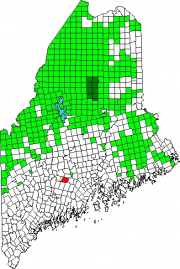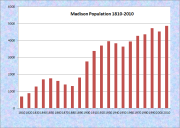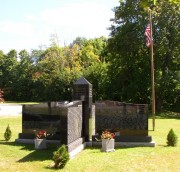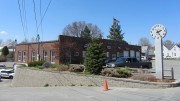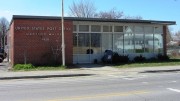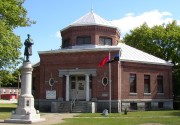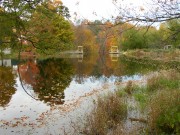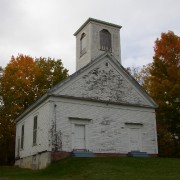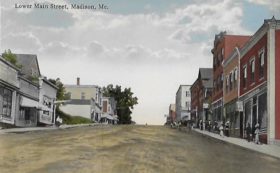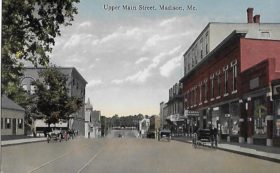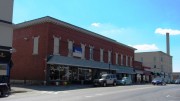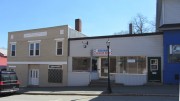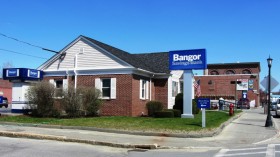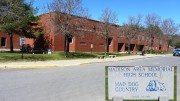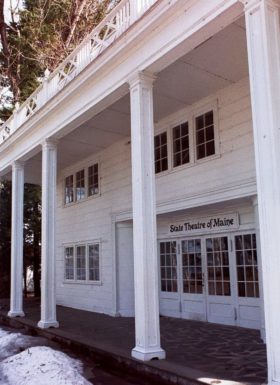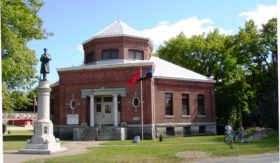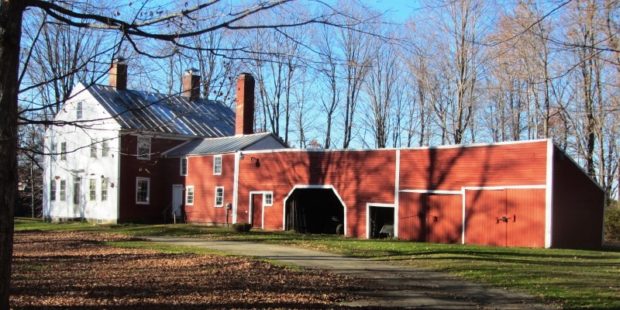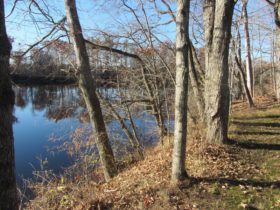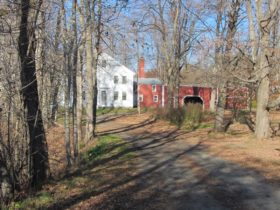| Year | Population |
|---|---|
| 1970 | 1,964 |
| 1980 | 2,552 |
| 1990 | 3,105 |
| 2000 | 3,294 |
| 2010 | 4,855 |
| Geographic Data | |
|---|---|
| N. Latitude | 44:48:45 |
| W. Longitude | 69:48:45 |
| Maine House | Dists 107,111 |
| Maine Senate | District 3 |
| Congress | District 2 |
| Area sq. mi. | (total) 54.6 |
| Area sq. mi. | (land) 51.8 |
| Population/sq.mi. | (land) 93.7 |
County: Somerset
Total=land+water; Land=land only |
|
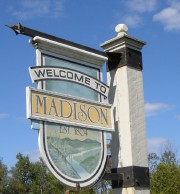 [MAD-ih-sun] is a town in Somerset County, incorporated March 7, 1804. In 1846 it ceded land to Norridgewock.
[MAD-ih-sun] is a town in Somerset County, incorporated March 7, 1804. In 1846 it ceded land to Norridgewock.
Father Sebastian Rasles arrived in 1695 in the Old Point area, living with and ministering to the Indians there until he was killed by the British in 1724. He built the first church in the town.
Named for President James Madison, it was surveyed in 1791 and permanent white settlers arrived at least by 1775. In that year Benedict Arnold’s Expedition camped for a week at Norridgewock Falls that spanned the Kennebec River across to Anson. The falls provided the base for the dam between the two villages.
The Carnegie Library, on the National Register of Historic Places, was built in 1906 with a grant from Andrew Carnegie. The Madison veterans memorial and Civil War memorial are nearby.
The site of many mills in its history, Madison’s largest has been a paper mill at the dam where U.S. Route 201 crosses the Kennebec River from Anson. Until the end of the log drives in 1976, the river was often choked with pulp logs destined for this mill and others downstream.
The woolen mill, on the north side of Route 201 was established in the late 19th century and was the major employer for many years.
A survey of labor organizations in 1903 found no mill-related unions in the town, in contrast to other textile and paper mill communities. The two unions in that year, formed in 1902, were the Stationary Firemen and the Carpenters and Joiners.
Madison was home to Maine’s first astronaut and Air Force Test pilot, Robert Rushworth, who flew the rocket plane known as the X-15, in which he attained an altitude of 54 miles on June 27, 1963.
The Lakewood Summer Theater, opened in 1901 in East Madison, on the west side of Lake Wesserunsett, a three mile long, one mile wide recreational attraction. On the east side of the lake in the village of East Madison, a dam hints at its history as a mill site.
In the village of East Madison, an old meetinghouse, recently renovated, sits alone beside the East Madison Road.
Downtown Madison was a study in contrasts in 2013: older businesses and buildings in disrepair; newer businesses apparently thriving.
Geographically located in south-central Maine, the town’s western border is defined by the winding Kennebec River, once choked with pulp logs on their way to the paper mills in Madison and beyond.
Form of Government: Town Meeting-Select Board-Manager.
Additional resources
Clark, Emma Folsom. History of Madison, Maine: with new every name index. Rockport, Me. Picton Press. 2003.
Dean, Stella. History and Memories of Twelve Corners. 1992? (Skowhegan, Me. Scott Berry of the Paper Clip)
Hargreaves, Jack. Panning Gold: A Maine Memoir. Madison, Me. Maple Leaf Editions/Soleil Press. 2003.
“Old Home Week, Madison and Anson (Maine), August 7-13, 1927.” 1927 (At Maine State Library)
*Maine. Historic Preservation Commission. Augusta, Me. Text and photos from National Register of Historic Places: http://pdfhost.focus.nps.gov/docs/nrhp/text/xxxxxxxx.PDF and http://pdfhost.focus.nps.gov/docs/nrhp/photos/xxxxxxxx.PDF
Lakewood Theatre: 75000111.PDF
Madison Public Library: 88003022.PDF
Old Point and Sebastian Rasle Monument: 73000147.PDF
Weston Homestead: 77000086.PDF
Prince, Nettie E. Diary, 1904 Feb. 20-Dec. 31. Diary of a woman living in Madison. Entries are short and include weather observations, work done by farm laborers, trips made, descriptions of work done around the house such as washing, baking, cooking, sewing, and cleaning, and a record of her financial affairs. (University of Maine, Fogler Library, Special Collections.)
Sleeper, Frank F. Madison, Norridgewock, and Smithfield. Dover, N.H. Arcadia Publishing. c1998. (Pictorial)
Weston, Samuel. Samuel Weston’s Field Book, Jan. 1791: of the survey of three townships on the east side of Kennebec River, viz, no. 1, 1st range, now Madison, no. 2, 1st range, now Cornville, no. 1, 2nd range, now Solon: to which is added the survey of the settlers lots. Transcribed by John E. Leland. Madison, Me. J.E. Leland. 2002. [Maine State Library]
National Register of Historic Places – Listings
Lakewood Theatre
[northeast of Madison village on the bank of Lake Wesserunsett] Many trolley car systems in the late 19th century developed amusement centers in scenic locations along their lines. Such a park was developed in 1895 in Lakewood Grove on the shore of Lake Wesserunsett by the Somerset Traction Company of Skowhegan. Along with other amusement features, it established the Lakewood Theatre in 1898. Between 1925 and 1941 it became the most important summer theatre in the country.
Its rise to prominence was begun by Herbert L. Swett, a young man who became manager in 1901 and developed an organization and physical plant that was to become the premier summer theatre for two decades with the longest continuous record of summer seasons in America. From the 1920s until World War II it was the major tryout theatre for potential Broadway productions and became known as “Broadway in Maine.” The war caused a temporary cessation in 1943 and 1944, but from 1945 to the late 20th century the Lakewood Theatre completed a transition to the “package” system with a new cast each week.* [See Lakewood for photos and more background.]
Madison Public Library
[Old Point Avenue] Designed by the local architectural firm of Snow and Humphreys and completed in 1906, the Madison Public Library is among the most unusual of such buildings in the state. It is one of only eighteen whose construction was funded by a grant from Andrew Carnegie.
Madison’s public library traces its history to a meeting held by local townspeople on January 4, 1886. The founders of the Madison Library Corporation pledged to raise $250 for the purposes of establishing a library provided that the town would match this figure. Their mission successfully completed, the organizers opened the library on April 30, 1887, in the second floor of a commercial building. By 1904 the collection had apparently outgrown its space and measures were taken to find a solution. Andrew Carnegie was approached for a grant and he provided $8,000. The library opened on January 3, 1907.*
Old Point and Sebastian Rasle Monument
[south of Madison off US 201A] The Norridgewock village site was the focus for French-English rivalry over frontier. The Abnaki village exerted the greatest resistance against the encroachments of English settlers. It was also the most important Indian mission in Acadia.
The first, Jesuit missionary at Norridgewock was on the Kennebec river at various times between 1646 and 1652. On one of these occasions he officially represented the French governor in an unsuccessful attempt to secure English help against the Iroquois. Between the 1650s and the late 1680s the Norridgewocks maintained their ties with the French and the Catholic religion via the Kennebec-Chaudiere river route to Quebec.
In 1695 Sebastian Rasle (also Rale) was assigned to the Norridgewock mission. Rasle was the spiritual and temporal leader of the tribe. The English believed that he inspired real and imagined French aggression. He also symbolized the Indians refusal to allow English expansion on the Kennebec river.
After the Treaty of Utrecht ended Queen Anne’s war in 1713, the English-Abnaki confrontation grew when the English refused to heed Rasle’s frequent warnings of the Indians’ grievances. Though Samuel Sewall, the colony’s Chief Justice, warned that the Indians’ complaints were real, Massachusetts succumbed to her fear of the French and the demands of land developers and declared war on the Abnakis. This conflict, variously called Dummer’s, Rasle’s, and Lovewell’s war, ended the Abnaki threat on the Kennebec river. Repeated legislative demands for the elimination of Rasle and the leading Abnaki chieftains led to a successful attack against Norridgewock on August 23, 1724.*
The Sebastian Rasle Monument is in the town of Madison, though the Abnaki village was called Norridgewock, which is the name of the town abutting Madison.
Weston Homestead
[north of Madison on Weston Avenue] This large, well preserved Federal house sits high above the banks of the Kennebec River. Its first owner, Deacon Benjamin Weston, was the son of one of the first settlers in the area. This substantial home, of unusually fine detail for such a remote area, provides an important link with the settlement of Madison.
In 1771 Joseph Weston and his eldest son visited a grant they had purchased n Canaan. During that summer they built a twenty foot square cabin. They brought their family from Massachusetts, arriving at the cabin in April 1772. Eunice Weston became the first woman to settle in Somerset County.
In 1775, when Col. Benedict Arnold reached Canaan on his expedition against Quebec, he was entertained by Joseph Weston, who guided by him for the next several miles up the river. As a result of his efforts Weston contracted a fever from which he shortly died.
As a young man his son, Benjamin, purchased 1000 acres in Madison, where he built his house in 1817. Close by he established a ferry over which all travel passed between Hallowell, Augusta and Waterville and the upriver settlements of North Anson and New Portland. No charge was ever made for clergymen, funeral processions or those on their way to church. Benjamin’s son, Nathan, was a leader in the community until his death at the age of 94. He helped fund the first railroad bridge over the river at Madison and contributed heavily to the first church building.*
Norridgewock Archeological District, Address Restricted
Benedict Arnold’s Expedition Route – click a Bateau

 <== To Quebec To Beginning ==>
<== To Quebec To Beginning ==>



